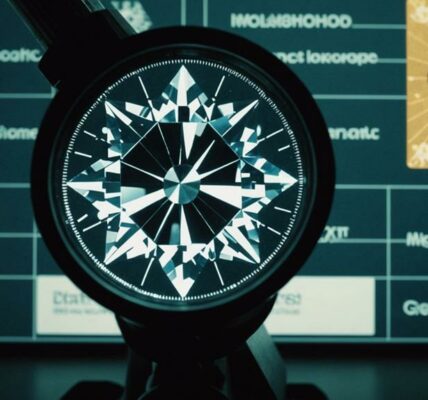Anglo American is considering a historic move to sell its stake in the diamond giant De Beers. Founded in 1888, De Beers once held a near-monopoly over the diamond trade. However, Anglo American is shifting its focus towards vital resources like copper and iron ore due to declining diamond sales and a significant drop in revenue. This divestment aligns with their “Origins” strategy, which seeks to cut costs and enhance marketing efforts. A potential new ownership agreement with Botswana could reshape De Beers’ future. As Anglo American redirects its priorities, De Beers’ strategic prospects await further transformation. Uncovering more could reveal exciting developments.
Article Contents
- 1 Main Highlights
- 2 De Beers’ Historical Dominance
- 3 Reasons Behind the Divestment
- 4 Anglo American’s Strategic Shift
- 5 Implications for De Beers
- 6 Future Prospects and Strategies
- 7 Frequently Asked Questions
- 7.1 How Will De Beers’ Branding Change Under New Ownership?
- 7.2 What Impact Will Divestment Have on De Beers’ Workforce?
- 7.3 How Might De Beers’ Retail Operations Be Affected by Divestment?
- 7.4 Will New Ownership Influence De Beers’ Sustainability Practices?
- 7.5 How Will De Beers’ Partnerships Be Managed Post-Divestment?
- 8 Conclusion
Main Highlights
- Anglo American is considering divesting its stake in De Beers to concentrate on core commodities such as copper and iron ore.
- De Beers currently holds a 34.5% market share by value in the diamond industry.
- The potential divestment aligns with Anglo American’s strategy to achieve £1.7 billion in cost savings.
- Future ownership changes could significantly influence De Beers’ strategic direction and market influence.
- The divestment decision is part of Anglo’s broader strategic “Origins” initiative to enhance marketing and reduce costs.
De Beers’ Historical Dominance
In 1888, De Beers Consolidated Mines, Ltd. was formed, marking the beginning of a near-monopoly over the diamond trade originating from South Africa. This strategic move allowed De Beers to consolidate control over both the production and distribution of diamonds, transforming the global market landscape. The South African diamond rush of the 19th century, which threatened to flood the market, was deftly managed through the leadership of the Oppenheimer family, especially Ernest Oppenheimer.
Oppenheimer’s vision and strategic acumen propelled De Beers into a position of unparalleled influence. De Beers’ diamond monopoly was further solidified through strategic acquisitions and alliances, such as “The Diamond Syndicate,” which guaranteed a tight grip on the industry. The creation of the Central Selling Organisation (CSO) centralised diamond distribution, stabilising prices and preventing market volatility.
The Oppenheimer family maintained control over the diamond industry for 80 years, ensuring that De Beers remained a dominant force. The marketing evolution of De Beers was revolutionary, associating diamonds with love and romance through clever advertising campaigns. This not only expanded their reach into lucrative markets like the United States and Japan but also transformed diamonds into timeless symbols of commitment.
De Beers’ groundbreaking branding strategies and focus on high-end jewellery secured its dominance, leaving an indelible mark on the global diamond market. De Beers currently holds a significant 34.5% market share by value, reflecting its ongoing influence in the global diamond industry.
Reasons Behind the Divestment
While De Beers has historically maintained an unassailable dominance in the diamond industry, recent market dynamics have compelled the company to reassess its strategic direction. The combination of declining revenue and competition from lab-grown diamonds has presented significant market challenges, pushing Anglo American to contemplate divestment as a viable solution.
Key factors contributing to the divestment rationale include:
- Revenue and Sales Decline: De Beers experienced a 21% revenue drop in the first half of 2024, coupled with a 22% decrease in sales volume of rough diamonds, underscoring the financial pressures.
- Competition from Lab-Grown Diamonds: These alternatives are gaining consumer attention, challenging the demand for natural diamonds and impacting traditional diamond markets.
- Strategic Initiatives and Cost Reduction: To counteract these challenges, De Beers launched its “Origins” strategy, aimed at reducing costs by $100 million annually and focusing on marketing collaborations to enhance demand.
- Divestment Strategy: Anglo American’s plan to divest or demerge De Beers aligns with its focus on other assets such as copper and iron ore, reinforcing the need for a strategic shift. This strategic restructuring represents the most significant change for the company in decades, highlighting its commitment to simplifying its portfolio and capitalising on resource opportunities. Despite these efforts, the weakened demand for natural diamonds continues to pose a significant hurdle, complicating market recovery and influencing divestment considerations.
These elements highlight the necessity for De Beers to adapt to evolving market conditions and redefine its business model.
Anglo American’s Strategic Shift
Anglo American frequently reassesses its strategic priorities to maintain a competitive edge, and its latest strategic shift underscores a significant transformation in its business model. The company is honing its asset focus by concentrating on core areas like copper, premium iron ore, and crop nutrients. This shift involves a thorough portfolio simplification, significantly divesting non-core businesses such as De Beers and Anglo American Platinum. Such moves are designed to streamline operations and optimise shareholder value.
The restructuring plan, described as the most radical in decades, is set to be completed by the end of 2025. By reducing investments in the fertilisers business from £1 billion to £200 million, Anglo American aims to reallocate resources to areas with higher growth potential. Amid economic uncertainties, Anglo American is determined to adapt to evolving market dynamics by focusing on commodities with stable demand.
The divestment of De Beers is a critical component, contributing to the $1.7 billion cost-saving target. This strategic realignment allows Anglo American to emerge as a more concentrated and focused entity, poised for improved growth and efficiency. De Beers, under new ownership, is expected to explore opportunities and leverage strategic advantages in the diamond market.
Implications for De Beers
As De Beers prepares for a potential divestment by Anglo American, the implications for the diamond giant and the broader market landscape are profound.
With De Beers commanding roughly 35% of the global rough diamond supply, any change in ownership could ripple through the industry, sparking market volatility and varied stakeholder reactions. This is especially notable as the market already grapples with existing pressures, such as sanctions on Russian diamonds and the rise of lab-grown alternatives. This divestment comes amid a notable decline in rough diamond sales, with 2023 sales totalling £3.63 billion, a 37% decrease from the previous year, highlighting the challenges faced by the industry. Anglo American has announced the divestiture of De Beers on 14 May 2023, which signifies a pivotal shift in its corporate strategy.
- Market Volatility: The divestment could lead to fluctuations in diamond prices and availability, causing uncertainty among stakeholders.
- Stakeholder Reactions: Key players, like De Beers’ sightholders, are cautiously optimistic about the potential benefits of new ownership and strategies.
- Botswana’s Role: With its 15% stake in De Beers, Botswana’s interest in increasing its share could considerably influence future company decisions and strategies.
- Corporate Dynamics: Anglo American’s divestment aims to improve strategic flexibility, reflecting broader corporate restructuring trends.
As the divestment unfolds, the diamond industry remains in a state of anticipation, keenly observing how these changes will shape the future of this iconic company and its market influence.
Future Prospects and Strategies
De Beers is poised to redefine its strategic outlook as it navigates potential changes in ownership. The diamond giant is focusing on groundbreaking diamond marketing strategies to rekindle interest and demand for natural diamonds. By collaborating with retailers, De Beers aims to secure its position in a competitive market, ensuring that its legacy endures. Moreover, the company plans to streamline operations by cutting $100 million in costs, concentrating on strategic projects in South Africa and Botswana. As part of its future planning, De Beers anticipates finalising a transformational agreement with the Botswana government, which is crucial for the future ownership structure of the company.
Retail expansion plays a critical role in De Beers’ future strategy. By diversifying its retail approach, the company is placing emphasis on its Forevermark brand in India and opening a flagship De Beers Jewellers store in Paris. This expansion is designed to capture new markets and improve brand visibility, creating fresh opportunities for growth.
These strategic moves are underscored by a favourable market recovery, with a positive outlook for rough diamond demand. De Beers is committed to delivering value to its stakeholders, including partners in numerous countries. As De Beers supports beneficiation growth in Botswana, it strengthens its local economic impact, reflecting its commitment to the region’s development.
As Anglo American investigates divestment options, a new ownership structure could provide De Beers with the strategic flexibility needed to continue shaping the diamond market.
Frequently Asked Questions
How Will De Beers’ Branding Change Under New Ownership?
De Beers’ branding under new ownership will likely improve its unified brand identity, shifting consumer perception towards a more cohesive and streamlined approach. This transformation aims to maintain global recognition whilst aligning operations with strategic flexibility and value creation.
What Impact Will Divestment Have on De Beers’ Workforce?
How will divestment affect workforce morale and employee retention? Amidst restructuring and potential redundancies, the uncertainty of new ownership could challenge morale. Yet, could a fresh approach invigorate the workforce, fostering retention and adapting to industry changes?
How Might De Beers’ Retail Operations Be Affected by Divestment?
De Beers’ retail operations may experience improved strategic flexibility, enabling refined retail strategies and bolstered market positioning. This potential independence could invigorate expansion, fostering a more agile and competitive approach within the luxury-branded jewellery sector.
Will New Ownership Influence De Beers’ Sustainability Practices?
Like a river reshaping its course, the change in ownership may invigorate De Beers’ sustainability initiatives. The company could plot a course towards more cutting-edge practices with new strategic flexibility, reinforcing its commitment to environmental and social responsibility.
How Will De Beers’ Partnerships Be Managed Post-Divestment?
After divestment, De Beers’ partnership dynamics will necessitate careful management, concentrating on future collaborations with government entities such as Botswana. Any new ownership must prioritise strategic alliances, ensuring continuity and growth, while respecting existing commitments to partner countries.
Conclusion
The potential divestiture of De Beers by Anglo American marks a pivotal moment, akin to a ship changing course in calm seas. This strategic shift reflects broader industry dynamics and evolving priorities within the parent company. The implications for De Beers are significant, as it must navigate new waters and adapt its strategies for sustainable future growth. The diamond giant’s historical dominance provides a strong foundation, yet it faces challenges that require creative approaches to maintain its esteemed position.




